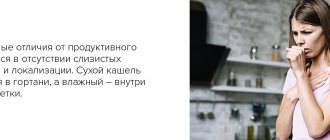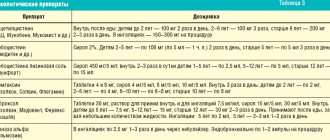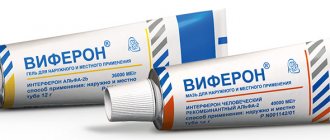Causes of sore throat
The appearance of an unpleasant symptom is most often associated with an upper respiratory tract infection. But this is not the only reason why your throat starts to feel sore.
An unpleasant feeling appears when a person accumulates moral tension. It comes out physically through the constant desire to cough. This is especially noticeable before performances: people first seem to “clear” their throats or take a sip of water. This allows you to stop the tickling and start speaking.
Discomfort in the throat may be associated with thyroid disease. The symptom also occurs in people who inhale chemicals with a burning effect on the mucous membranes for a long time. Most often this is an occupational hazard. Or the mucous membrane is irritated by gastric juice, which is thrown through the esophagus in some gastrointestinal pathologies. There is also a dry paroxysmal cough and a sore throat due to cigarette smoke. Especially if it is inhaled by a person who is not used to it, or if it enters through the nose.
The cause of soreness may be drying out of the oropharyngeal mucosa. It appears when there is difficulty breathing through the nose or excessively dry air (due to heating or working with very hot objects). Perspiration often occurs with increased vocal load - among singers, artists, and public figures.
Cough is the most common reason for visiting a doctor among respiratory manifestations; its feature is heterogeneity - development as a result of various factors. The scientific literature describes 53 possible causes of cough [1]. Establishing the etiology of cough is extremely important, since it is the elimination of its root cause that largely ensures the success of treatment. Acute cough is most often a symptom of a respiratory viral infection, lasts no more than 2 weeks, can be successfully treated and does not lead to serious complications. The cause of a persistent, difficult-to-treat cough is more difficult to determine, and in some patients there may be more than one factor causing the cough. Even in developed countries with a high level of healthcare, in more than 20% of cases the source of chronic cough remains unknown [1–8].
An intense dry cough as a result of a strong forced release of air from the respiratory tract significantly increases intrapulmonary and intrathoracic pressure, which reduces the flow of air into the alveoli, can contribute to the development of emphysema of the pulmonary tissue, the formation or enlargement of hernias, and has a negative impact on the functioning of the cardiovascular system. A tense cough often contributes to the development of heart rhythm disturbances; rare complications of cough are described as hemorrhages in the brain and retina in patients with vascular pathology. Against the background of increased intrathoracic pressure at the time of coughing, some patients develop bettolepsy - a short-term loss of consciousness or convulsions. In some cases, patients with intense long-term cough complain of fatigue, malaise, insomnia, voice changes, somatic pain, sweating, and urinary incontinence. Thus, persistent long-term cough significantly worsens the quality of life [1-3, 6, 7, 9].
One of the pathological varieties of cough is its reflex form, which is a symptom of a disease outside the pathology of the bronchopulmonary system. Reflex cough is a neurotic condition manifested by a dry paroxysmal cough during the day or night. Over time, a long-lasting cough almost always acquires a reflex character due to changes in the functional state of cough receptors and corresponding nerve centers [4, 5, 9, 10]. Coughing attacks may be accompanied by laryngospasm, a feeling of suffocation, and do not respond well to classical treatment methods. This condition can mimic bronchial asthma or be combined with it.
According to our clinic, in recent decades there has been an increase in patients with reflex cough, which corresponds to a general increase in the frequency of development of various neurotic conditions. A reflex cough can be of both central and peripheral origin, developing accordingly with pathological irritation of the cough center of the medulla oblongata or peripheral receptors of the vagus nerve. A number of researchers indicate that a reflex cough is formed against the background of neurogenic hyperventilation syndrome (HVS), while concomitant pathological processes are provoking factors for its manifestation. This point of view is confirmed by the results of our previous studies. This explains the long-term persistence of reflex cough even after the elimination of the factors that provoke it [4, 5, 9—11].
It is known that HVS is caused by psychogenic or organic (5% of cases) dysfunction of the central nervous system, manifests itself in various clinical disorders and leads to the formation of a stable pathological type of breathing, but to date the reasons for the development and maintenance of this syndrome remain unclear. Hyperventilation - an increase in the depth and frequency of breathing - disrupts gas exchange processes in the lungs, causes excessive release of carbon dioxide, the development of hypocapnia with a decrease in the partial pressure of carbon dioxide in the alveolar air and respiratory alkalosis. Unconscious, too deep and frequent breathing causes such patients to feel a lack of air. It is respiratory alkalosis, along with a decrease in the level of ionized calcium, that causes an increase in the level of neuromuscular excitability, including spasm of the laryngeal muscles, and provokes coughing attacks [9-12].
Signs of a reflex cough are its dry, hacking nature, gradual increase or sudden onset, inability to stop the attack, feeling of lack of air. It is characteristic that patients themselves localize the place of onset of reflex cough in the area of the anterior surface of the neck. Factors that trigger the onset of an attack include deep breathing, talking, stressful situations, smoke inhalation, and fatigue. In addition to coughing, patients are concerned about dryness and sore throat, a feeling of lack of air and a “lump in the throat.” Against the background of HVS, various pathological changes can develop not only in the respiratory tract, but also in the cardiovascular and digestive systems, psycho-emotional status, thermoregulation, as well as motor disorders, tetany [10, 11]. Paradoxical manifestations of hyperventilation syndrome are periodic sighs, arrhythmic breathing, unmotivated yawning, snoring, licking lips, and coughing. Such signs, in the absence of deep respiratory movements, often do not attract the attention of doctors and patients, but can support hypocapnia and respiratory alkalosis [8, 10-12].
A reflex cough can develop against the background of inflammatory diseases of the ENT organs, with unilateral paralysis and paresis of the larynx, prolapse of the membranous part of the trachea, pathology of the pleura, pericardium, thyroid gland, gastrointestinal tract, the presence of a diaphragmatic hernia, increased sensitivity of the body to any substance, including allergies due to taking angiotensin-converting enzyme inhibitors. We observed patients whose trigger for reflex cough was surgery under anesthesia, childbirth, or tracheostomy. A dry paroxysmal cough can persist for a long time in patients after infectious processes such as whooping cough, mycoplasma and chlamydial infections, influenza and others. Against the background of whooping cough (pathogen Bordetella pertus sis
) cough is caused by constant irritation of the receptors of the respiratory tract, which leads to the formation of a focus of excitation of the dominant type in the respiratory center and its preservation for several years. In addition, the neurotropic pertussis toxin affects the cough center in the medulla oblongata and contributes to the formation of a vicious circle. Attacks of spastic whooping cough and post-whooping cough can also be provoked by nonspecific irritants [1-3, 5, 9-12].
Assessing the characteristics and parameters of cough against the background of various diseases helps the doctor make the correct diagnosis for a particular patient. It is necessary to conduct a thorough differential diagnostic search, including with the participation of various specialists - pulmonologist, cardiologist, otolaryngologist, endocrinologist, neurologist, psychiatrist. Undoubtedly, it is difficult to diagnose a type of reflex cough - psychogenic, especially in the absence of any organic disorders and when the patient is confident in the presence of a causative disease of the respiratory tract.
When examining patients with reflex cough during medical history collection, it is extremely important to pay attention to the presence of a chronic psychotraumatic situation, the occurrence of coughing attacks against the background of stress, increased physical or prolonged vocal stress. An attack of reflex cough usually begins with a sharp dryness and soreness in the throat. When performing laryngoscopy, you should pay attention to such characteristic signs as an increased pharyngeal reflex, a wide glottis - 20 mm or more (usually up to 15 mm), spasm of the vocal folds during inspiration, sometimes convulsive closure of the vocal folds, the occurrence of a coughing attack at the time of examination . When studying the function of external respiration, moderate hyperventilation is detected in 1/3 of patients, while in the rest, the indicators remain within normal limits. Additional diagnostic criteria are a positive hyperventilation test and an electromyographic test for latent tetany, a low level of ionized calcium in the blood, and the lack of effect from the use of antitussive drugs [9–11].
The management tactics for such patients are largely determined by the etiotropic factor; if possible, it must be eliminated. It is also advisable to prescribe symptomatic (cough suppressant) and sedative medications. Doctors have at their disposal antitussive drugs of central, peripheral and combined action. Irrational use of antitussive, mucoactive, antibacterial and anti-inflammatory drugs, including hormonal drugs, and repeated diagnostic procedures can contribute to the development of side effects, lead to unsatisfactory results and adverse iatrogenic consequences. Treatment of such patients should be personalized, using pharmacotherapy, non-drug methods, and in some cases the possibility of surgical intervention is discussed [1, 9, 10, 12-15].
Our clinic has accumulated some experience in treating patients with laryngoneurosis in the form of reflex cough. Based on a fairly large volume of clinical data (more than 500 patients), we came to the conclusion that the management of such patients should include identification and elimination of the causative factor, breathing exercises to relieve hyperventilation, sedation and psychotherapy, reflexology - intradermal novocaine blockade of the Zakharyin-Ged zones for larynx and auricular reflexology, B vitamins, calcium supplements as indicated. The doctor needs to establish psychological contact with the patient, explain the mechanism of development of the disease and convince him of the effectiveness of treatment, as well as the absence of the risk of suffocation. The patient’s understanding that all pathological manifestations are caused by an excess, not a lack of air, and strict adherence to the doctor’s recommendations are extremely important for recovery. Breathing exercises involve switching to the diaphragmatic type of breathing, shortening the time of inhalation relative to exhalation by half, and reducing the breathing rate. The method of intradermal novocaine blockade of the Zakharyin-Ged zones for the larynx was developed and patented by an employee of our clinic, Prof. O.Yu. Karpova [16] and is based on the idea that internal organs and their corresponding dermatomes are associated with the same structures of the central nervous system. When exposed through novocaine blockades to skin receptors in the corresponding Zakharyin-Ged zones, inadequate impulses from the pharynx and larynx are reduced, the central pathological dominant is gradually eliminated and the normal function of the interested structures is restored, which is manifested by the cessation of reflex cough.
Currently, in the Clinic of Ear, Nose and Throat Diseases of the First Moscow State Medical University named after. THEM. Sechenov examined and successfully treated more than 500 patients with reflex cough. Clinical manifestations and anamnestic data, as well as a laryngoscopic picture (anatomically wide glottis, spasm of the vocal folds during inspiration, high pharyngeal reflex) confirmed the diagnosis. Considering that the psychogenic factor plays a significant role in the occurrence of reflex cough, 26 patients underwent a psychodiagnostic study using the SMOL-EXPERT computer system.
In 22 cases, a change in personality structure was revealed with a predominance of psychasthenic, hypochondriacal and depressive changes. Internal tension, decreased mood and anxiety, and increased sensitivity to stress were the leading personality traits. In 4 patients, hysterical-hypochondriacal radicals were determined; therefore, they were characterized by anxious and suspicious traits and a predisposition to anxious reactions to any events [17]. Also, before the start of treatment, patients were monitored the level of ionized fraction of calcium in the blood.
All patients underwent complex treatment, including 10 procedures of intradermal novocaine blockade of the Zakharyin-Ged zones for the larynx and auricular reflexology, breathing exercises aimed at relieving hyperventilation, sedatives, muscle relaxants to relieve pathologically increased tone of the laryngeal muscles, calcium supplements as indicated, as well as antitussive drugs.
In 2021, the use of the drug rengalin began as part of complex therapy for patients with reflex cough. Rengalin contains polyclonal, affinity-purified antibodies to bradykinin, histamine and morphine in the form of technologically processed (potentiated) ultra-high dilutions. The drug is release-active, i.e. it has a special modifying activity that is released during the technological processing of the original antibodies. Antibodies to bradykinin, histamine and morphine in a release-active form are capable of changing the activity of endogenous regulatory molecules, and therefore the processes associated with them. A special feature of the drug is its ability to influence the central and peripheral parts of the cough reflex, changing the interaction of endogenous regulators with the corresponding receptors involved in the formation of cough. The components of the drug modify the activity of the ligand-receptor interaction of endogenous regulators (opioids, histamine and bradykinin) with the corresponding receptors; in this case, the combined use of the components leads to an increase in the antitussive effect. In addition to the antitussive effect, the complex drug rengalin, due to its constituent components, has anti-inflammatory, decongestant, antiallergic, antispasmodic and analgesic effects. Unlike narcotic analgesics, it does not cause respiratory depression, drug dependence, and does not have a narcotic or hypnotic effect. Rengalin is indicated for adult patients and children over 3 years of age with acute and chronic respiratory tract diseases, accompanied by cough and bronchospasm, for any cough against the background of influenza and ARVI, acute pharyngitis, laryngotracheitis, acute obstructive laryngitis, chronic bronchitis and other infectious-inflammatory and allergic diseases upper and lower respiratory tract.
In the Clinic of Ear, Nose and Throat Diseases of the First Moscow State Medical University named after. THEM. Sechenov, 15 patients with reflex cough received the previously proposed complex conservative treatment in combination with the innovative drug rengalin. The age of the patients ranged from 28 to 76 years. The duration of the disease history ranged from several weeks to 6 years. 3 patients had concomitant unilateral recurrent laryngeal nerve palsy, 2 had a history of whooping cough. The main complaint of all patients was a prolonged unproductive paroxysmal cough, periodically interrupted by laryngospasms; they were also concerned about a feeling of lack of air and rapid voice fatigue. The severity of cough was assessed by patients on a scale from 0 to 10 during the day and at night, depending on the frequency and intensity of attacks (according to the “Cough Severity Scale”); the provoking factor was also taken into account.
The duration of the study was 10 days, during which patients received Rengalin 2 tablets 3 times a day and filled out a questionnaire, noting the frequency of coughing attacks, the impact of symptoms on daily activity/sleep, recording factors that provoke the development of a coughing attack, monitoring the presence or absence of sputum, as well as voice changes. The average cough severity score at the beginning of treatment was 6.2 points during the day and 3.5 points at night. The most common triggers for paroxysmal dry cough in patients were talking, laughing and physical activity.
All patients showed a significant improvement in their condition on average from the 3rd day of therapy, with the exception of one patient, who on the 8th day of treatment experienced the appearance of acute catarrhal symptoms, as well as stress, against the background of which the severity of the cough began to increase again. Complete recovery was observed in 6 patients on the 10th day of treatment. Our results demonstrate the effectiveness of the drug rengalin against cough of a reflex nature as part of complex therapy.
Thus, in our opinion, the treatment of patients with reflex cough and laryngoneurosis should be carried out by an otorhinolaryngologist who has the necessary skills in diagnosing and treating such a contingent of patients, including methods of reflexology, breathing exercises and psychotherapy. In cases where a reflex cough is only one of the manifestations of severe general neurosis, it is advisable to refer patients for treatment to a psychoneurologist. When a reflex cough is combined with another pathology, its relief is necessary, since the elimination of this pathological symptom facilitates the course of concomitant diseases and improves the quality of life.
The authors declare no conflict of interest.
*e-mail: [email protected] ; https://orcid.org/0000-0001-7414-1293
Possible diseases
A paroxysmal cough and sore throat appear in many diseases. Main pathologies:
- neurosis - an obsessive desire to cough without signs of diseases of the respiratory system;
- pharyngitis, laryngitis - pathologies of the respiratory system that occur due to viral or bacterial infection;
- allergic reaction - accompanied by lacrimation, nasal discharge, redness of the eyes;
- pathology of the thyroid gland - the growth of the organ creates discomfort in the throat, causing soreness;
- gastroesophageal reflux - failure of the gastric sphincter with the reflux of its contents into the esophagus and tissue irritation;
- nasal polyps, adenoiditis, deviated nasal septum - a person has to breathe more often through the mouth, which causes the mucous membrane to dry out and cause soreness.
The exact cause of the tickling is determined by the doctor based on the results of the examination. To do this, you need to see a therapist.
Causes of persistent cough
Before choosing a behavioral tactic and a possible treatment method, it is necessary to exclude diseases, the symptom of which may be a lingering cough. Among them are pneumonia, bronchitis, pleurisy, pharyngitis. Then you need to find out whether a lingering cough is an allergic reaction to animal hair, flowering or environmental pollution - according to the World Health Organization (WHO), any resident of a developed industrial center in some At this point, a reflex cough may appear. A lingering cough may develop in workers in hazardous industries and in smokers, including those who have recently quit. Even after completely quitting smoking, a reflex cough sometimes continues to torment a person for six months, because nicotine has irritated the cough receptors for a long time and they need time to recover. One of the common causes of a lingering cough is the restoration of the irritated mucous membrane of the respiratory tract after bronchitis or a respiratory disease . This process lasts up to a month and a half, during which any, even the most insignificant, irritant - for example, smoke or a strong smell - can lead to a coughing attack.
Diagnosis of pathology
Making a diagnosis begins with an examination by a therapist, collecting complaints, and taking an anamnesis. After this, a general blood test is prescribed.
If the cause cannot be established, the patient is referred to an otolaryngologist, endocrinologist and allergist, as well as for a consultation with a neurologist. You will need to additionally take a blood test for immunoglobulin E, a throat smear, and an ultrasound of the thyroid gland.
If the cause of the condition is not found, a consultation with a gastroenterologist and esophagogastroduodenoscopy is prescribed. Based on the results obtained, treatment is prescribed.
3. Symptoms and diagnosis
There are acute, subacute and chronic non-productive cough. The main criterion is the persistence of symptoms: if the cough is reduced within 3 weeks, it is considered acute; if it persists for more than 8 weeks, it is said to be chronic. In many cases, a dry cough is accompanied by a number of additional symptoms: chest pain, headache, weakness, shortness of breath, weight loss, etc.
Today, the exact cause or causes of a nonproductive cough can be established, according to various estimates, in 90-100% of cases, although sometimes this requires an in-depth examination and takes some time. The first diagnostically significant sign for a specialist is the nature of the cough; There are such varieties as:
- barking (usually with lesions of the trachea or larynx);
- small and frequent (pleural pathology);
- bitonal (tumor processes);
- night "heart";
- whistling asthmatic, etc.
Anamnesis is studied, examination, auscultation, and percussion examination of the chest are performed. In case of diagnostic doubts or ambiguities, laboratory tests of blood, urine, sputum (if the required amount can be collected with a dry cough), radiographic and/or tomographic studies, bronchoscopy, diagnostic bronchoalveolar lavage (wash), biopsy and other procedures as indicated are prescribed. As necessary, specialized specialists are involved (oncologist, infectious disease specialist, neurologist, etc.).
About our clinic Chistye Prudy metro station Medintercom page!
Principles of treatment
The key to successful treatment is identifying the cause. There are several areas of therapy:
- sedatives - help with neurosis;
- anti-inflammatory drugs - used for infectious diseases;
- antihistamines - effective for allergies;
- antitussives - block cough receptors;
- antibiotics - help against bacterial infections if other remedies are ineffective;
- Cough lozenges - relieve discomfort, moisturize the mucous membrane due to increased secretion of saliva.
If the cause of tickling is chronic poisoning by vapors of volatile substances or tobacco smoke, it is worth minimizing contact with the irritant. This will help get rid of the unpleasant symptom.
Read also: Swelling of the throat
Dear patients! Remember that only a qualified doctor can make an accurate diagnosis, determine the causes and nature of the disease, and prescribe effective treatment. You can make an appointment with our specialists or call a doctor at home by calling 8-(4822)-33-00-33
Be healthy and happy!
Cough with bronchial asthma
This is a disease that has different clinical manifestations, including a cough form. With this form of the disease, cough may be its only manifestation and the only complaint of the patient. However, adequately selected anti-asthma therapy brings a good treatment effect, which confirms the correctness of the diagnosis.
For bronchial asthma, basic therapy is prescribed, including inhaled corticosteroids and bronchodilators. Bronchodilators, in turn, can be divided into drugs that act for a short time and drugs that act for a long time. Doctors also have combination drugs in their arsenal to treat this disease.
Cough due to postnasal drip
Cause of Drip syndrome
is a secretion that, when you have a runny nose, flows from the nasal cavity into the pharynx, its laryngeal part. The cough is reflexive in nature and appears as a result of mechanical irritation of the pharyngeal receptors. In this case, it is necessary to treat rhinitis that caused postnasal drip syndrome. And, of course, treatment depends on the genesis of this rhinitis. For non-allergic rhinitis, vasoconstrictors and antihistamines are prescribed. The combination of these drugs reduces swelling and mucus production. In the case of allergic rhinitis, glucocorticoids and cromoglycates in the form of a nasal spray are usually used.







